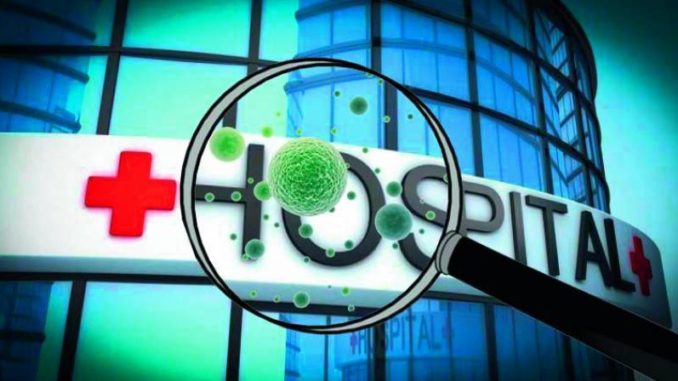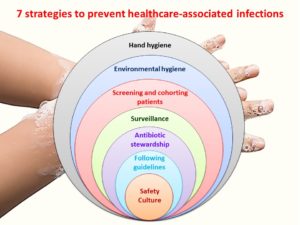
Table of Contents
What are Healthcare Associated Infections (HAI)?
- Health care Associated Infections (HAI) are the infections acquired in the health care settings.
- HAIs are the infections that a patient get while receiving treatment for medical or surgical conditions.
- HAI are not related to the original illness that patients bring.
- Infections which patients can get at a healthcare facility while being treated for other disease or conditions is known as HAI.
- These infections must be developed during hospitalization.
- Health care associated infection is also known as ‘nosocomial infections’ or ‘hospital acquired infections.’
- Health care associated infection (HAI) also include infections acquired by patients in the hospital or facility but appearing after discharge, and occupational infections among staff.
- To be considered as health care associated infection, the infection should neither be present nor incubating at the time of patient’s admission to hospital.
- It is mostly caused by viral, bacterial, and fungal infection.
Key Facts about Health care Associated Infections:
- Among every 100 hospitalized patients, 7 people in developed countries and 10 people in developing countries will suffer from HAI.
- The economic burden of HAI is more in low- and middle-income countries as compared to high income countries.
- Urinary Tract Infection is the most common HAI in high income countries.
- Prevalence of health care-associated infection in developed countries varies between 3.5% and 12%.
- According to the European Centre for Disease Prevention and Control, average prevalence of HAI is 7.1% in European countries.
- Prevalence of health care-associated infection varies between 5.7% and 19.1% in low- and middle-income countries.
- Surgical site infection is the leading HAI in low resource settings
- Newborns are at higher risk of acquiring HAI in developing countries.
Risk factors associated with Health care Associated Infections (HAI):
Three elements are required for the transmission of the HAI. They are:
- Source of microorganisms: It includes the varieties of exogenous microorganism exposed during the delivery of health care services.
- Host susceptibility: It includes the patient’s susceptibility of developing an infection after the exposure to pathogenic organism.
- Means of transmission: It includes mainly four common routes of transmission: contact (direct and indirect), respiratory droplets, airborne spread, and common vehicle through which infections gets transmitted.
Common types of Health care Associated Infections (HAI):
1. Central line-associated bloodstream infection (CLABSI)
- Central line is placed into a major vein near heart to give medicines and take blood.
- A serious infection can take place if pathogens enter into the blood stream through it.
- Therefore, a strict protocol must be followed while inserting the line keeping sure it is sterile.
2. Surgical site infection (SSI)
- This can happen after the surgery on the part where surgery took place.
- It can either be superficial or deep or deeper within the body with more serious complications.
3. Catheter-associated urinary tract infection (CAUTI)
- It is the most common type of HAI.
- The risk factor is the prolonged use of urinary catheter for draining urine.
- Therefore, catheter should be used in appropriate indications and removed as soon as they are no longer required.
4. Ventilator-Associated Pneumonia (VAP)
- Ventilator tubes help to get oxygen to lungs.
- An infection occurs when germs enters to the lungs through the tube and result in VAP.
Diseases/microorganism generally present in hospital setting which can be easily transmitted are:
- Influenza
- Tuberculosis
- HIV/AIDS
- Hepatitis
- Sepsis
- Staphylococcus
- Clostridium, etc.
Importance of Health care Associated Infections (HAI):
- HAI are threat to patient safety and has significant source of complications for the continuum of care
- These infections can cause illness ranging from mild to extremely serious life threatening conditions.
- It has the potential to spread out easily to various other health care facilities
- These also leads to prolonged hospital stays and increase in out-of pocket expenditure leading to financial burden
- However research studies shows that HAI can be prevented through various strategies
- Efforts on national leadership in surveillance, outbreak investigations, laboratory research can prevent healthcare-associated infections
Factors that increase the risk of Health care Associated Infections (HAI):
According to World Health Organization (WHO), factors that can cause HAI are:
- Prolonged and inappropriate use of invasive devices and antibiotics
- Highly risky and sophisticated procedures
- Immuno-suppression and other severe underlying patient conditions
- Insufficient application of standard and isolation precautions.
- Inadequate environmental hygienic conditions and waste disposal
- Poor infrastructure
- Insufficient equipment
- Understaffing
- Overcrowding
- Poor knowledge and application of basic infection control measures
- Lack of procedure
- Lack of knowledge of injection and blood transfusion safety
- Absence of local and national guidelines and policies
Preventive Measures for Health care Associated Infections:

There are various ways that can be applied for preventing healthcare associated infections. They are:
- Maintaining proper hand washing hygiene in the health care facilities by the health service providers
- Proper use of personal protective equipment like gloves, mask, face shields while coming in contact with the patients
- Implementing standard precautions
- Proper prescriptions of antibiotics and ensure of proper use of it to prevent antibiotic resistance
- Decontaminating the hospital setting environment
- Strengthening surveillance system and reporting mechanism of HAI for early detection and prevention of infection
- Reducing the possibility of infection during surgery by following all necessary protocols
- Ensuring minimum requirements in terms of facilities and dedicated resources
- Carrying out various research and validating surveillance protocols for development of evidence-based guideline for prevention of HAI
- Strictly adhering to evidence-based guideline in the hospital settings
- Using improved and advanced technology
- Following/complying with occupational health and safety protocols of health care workers
- Ensuring necessary vaccination
- Controlling endemic diseases in the hospital settings
- Sensitization and awareness among the staffs
- Improving accountability of the staffs
Challenges for Preventing Health care Associated Infections (HAI):
- Countries lack appropriate surveillance system for health care associated infections.
- Lack of appropriate standard criteria for diagnosing the infection.
- Limited public attention and awareness regarding HAI.
- Limited accountability among the staffs and health care personnel.
- Limited research to develop evidence-based guideline for prevention of HAI.
- Lack of compliance to the cleanliness and infection prevention measures.
Impact of Health care Associated Infections (HAI):
- Increased cost of care and financial burden for the health system
- Increased Out of Pocket Expenditure in low- and middle-income countries.
- High cost for patients and their families
- Increased hospital stays
- Creates long term disability
- Increased resistance to anti-microbials
- Increased unnecessary deaths
References and For More Information:
https://www.cdc.gov/hai/infectiontypes.html
https://www.ncbi.nlm.nih.gov/books/NBK2683/
https://patientcarelink.org/improving-patient-care/preventable-mortality/ https://www.ncbi.nlm.nih.gov/pmc/articles/PMC6245375/#b1-idr-11-2321
https://my.clevelandclinic.org/health/diseases/16397-avoiding-healthcare-associated-infections-hais
https://www.healthypeople.gov/2020/topics-objectives/topic/healthcare-associated-infections
https://apic.org/monthly_alerts/what-are-healthcare-associated-infections/
https://www.who.int/gpsc/country_work/gpsc_ccisc_fact_sheet_en.pdf